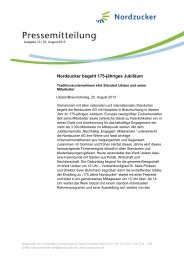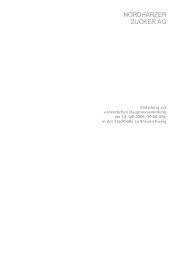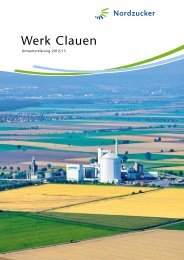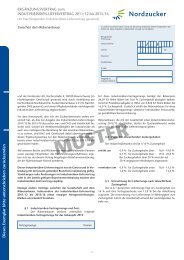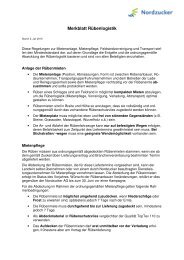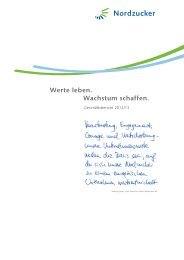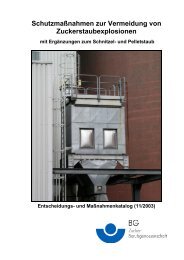downloads - Nordzucker AG
downloads - Nordzucker AG
downloads - Nordzucker AG
Create successful ePaper yourself
Turn your PDF publications into a flip-book with our unique Google optimized e-Paper software.
| PaNoraMa |<br />
A late, cold start to the beet year<br />
Delayed growth particularly in the German and Danish growing areas<br />
“In Denmark crops are lagging around ten days<br />
behind “normal” years. On a positive note, we are<br />
seeing high plant populations per hectare and<br />
excellent herbicide effects in all four countries.”<br />
Christer Sperlingsson, Senior Manager<br />
Beet Supply, Nordic Sugar<br />
“The long winter, wet soil and flooded fields did not<br />
allow for early sowing. We are all the more happy<br />
that our growers in Poland and Slovakia made use of<br />
all available resources and were able to get the beets<br />
planted in just 16 days.”<br />
Dr Gerd Jung, Senior Vice President, Beet<br />
Procurement <strong>Nordzucker</strong> Eastern Europe<br />
“Just like humans, beets don’t like being cold<br />
and wet! Our 2013 beet year is likely to be below<br />
average.”<br />
Volker Bückmann, Senior Vice President, Beet<br />
Procurement <strong>Nordzucker</strong> Central Europe<br />
In 2013, sugar beet sowing began later<br />
than the five-year average in most of the<br />
countries where <strong>Nordzucker</strong> grows sugar<br />
beet. Compared with the very early<br />
compact sowing in 2012, almost every<br />
<strong>Nordzucker</strong> beet office recorded a much<br />
later start to sowing at the beginning of<br />
April and much longer sowing periods<br />
were also widespread. In many places,<br />
orders had to be interrupted on several<br />
occasions due to late frost and heavy<br />
downpours. Sowing was fully completed<br />
in Germany, Poland and Slovakia at the<br />
end of April. Sowing in Denmark was<br />
also eleven days behind the five-year<br />
average. Only in Sweden was it possible<br />
for growers to drill their beet at their<br />
usual times – and even then there were<br />
major differences between growing areas<br />
in the west and the east.<br />
Very good initial conditions<br />
Good soil structure, mellowness due to<br />
frost and sufficient soil moisture ensured<br />
very good initial conditions across the<br />
board and thereby enabled even plant<br />
carpet levels to be achieved with optimum<br />
plant density. Likewise, the effect<br />
of herbicides was very good on the whole<br />
thanks to favourable soil moisture, although<br />
growth delays brought on by<br />
herbicide stress were observed locally.<br />
April and May were persistently<br />
cold and rainy months, particularly in<br />
Germany and Denmark. Sugar beets<br />
grew at a very slow pace and row closure<br />
was only observed at the end of<br />
June in many parts of both countries.<br />
Shortly after Whitsun, Germany was hit<br />
by local flooding and surface siltation<br />
following heavy rains. Low-lying parts<br />
of the beet catchment areas of the<br />
plants in Schladen, Nordstemmen and<br />
Clauen were particularly affected, with<br />
over 100 mm of rain per day and square<br />
metre falling on and around 25 May.<br />
Crops in Finland and Lithuania<br />
developed rapidly and very well under<br />
12







